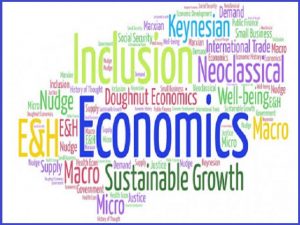India has emerged as a rapidly accelerating major economy in the world. It is expected to be
one of the top three economic powers in the world (according to Investopedia currently at 4th) over
the next decade, backed by its robust democratic policies and strong alliances. Indian economic
system is more of a traditional economic system that still follows the policies made before and after
colonization. A traditional economy is a system that relies on customs, history and time-honored
beliefs. In addition to this, India is the world’s first country, which had the world’s first written
economic system in the form of Vedas and after that by Chanakya during 323 BC.
Currently, most traditional economies are mixed economies and so is India, which
incorporates elements from capitalism, socialism and communism. Today, India’s economy is mostly
dependent on the service sector and the service sector accounts for 53.66% of total India’s GDP (Gross
Domestic Product), followed by the Industrial sector which is at the second spot and contributing
around 31% of the Indian GDP. India also ranks second globally in food production and exports were
38.5 billion. India’s agriculture sector accounted for 23% of the Indian GDP. Mentionable the productivity of the Indian economy was made possible by India’s shift towards a market
economy. Since the 1990s,India has deregulated several industries. India privatized many state-
owned enterprises and opened doors to foreign direct investments.

According to recent data from the RBI (Reserve Bank of India), India’s foreign exchange
reserve was Rs-39.64 trillion (US$ 542.01 billion) in the week up to September 4, 2020. With an
improvement in the economic scenario, there have been investments across various sectors of the
economy. The mergers and acquisition (M&A) activity in India stood at the United States $35.1
billion in the first half of 2020, while private equity (PE) deals stood at the US $13 billion.
India is seen as an exceptional power among some policymakers and academics -a bastion of
certain normative values standing for the marginalized in the global South. Examples of India’s
supposed moral foreign policy abound. However, a closer examination of India’s foreign policy since
its independence in 1947 suggests that India’s foreign policy calculations tend to be infused with
classical realism.
India should focus on policies and strategies that protect the interests of its citizen but
lately, particularly during the leadership of the Modi Govt. Several laws have been passed which
have aggregated the citizens of India including changing the currency (eliminating some of the
currency bills and bringing new farmers bills in the forms of ordinances without debate).
India has always been an agrarian country and farmers of India have been following the
trend of “Mandis”(wholesale vegetable and grain markets, controlled by govt.) recently, some new
agricultural laws have been made which allow the farmers to set their own prices and shops, which
means there will be no more Mandis. These new laws will not allow the farmers to pursue their
disputes in the court of law and order and gives them only remedial lean ways to seek justice from
the interference of the local administrations. This new law has angered the farmers, which are now
on full display and are being exposed and exploited. They will now lose their lands and it will sort of
privatizing their crop production. The protesting farmers believe that the new laws have been
drafted to facilitate ease of doing business for large corporations and the “biggies”, eliminating
safeguards for farmers and leaving them vulnerable. In foreign countries like the USA, Canada and UK people can file bankruptcies during their hardships and restart their financial life, but in India, it is
not possible for the small farmers and general public.
India’s roots have always been to protect the interest of all but now it’s shifting and
deviating from its original path, this seems like India’s strategy is to compete for the already
developed and stable foreign markets to put forward the biggies as the representatives and to
spread an invisible cloak over the slums and the underserved, who will be pinched hard.
India’s youth unemployment rate has been hovering around the 23 percent mark for a
decade now, however 23% of youth is unemployed and the employed youth is dissatisfied with their job
profile, payouts, and work-life satisfaction and job security. India is also affected by brain-drain,
where most of India’s youth prefer working abroad due to better recognition, job security and pay-
scales and opportunities. That is the reason many youths go abroad in unauthorized ways such as
crossing borders and even applying for political asylum for nonpolitical reasons, it is a kind of
financial asylum for Indian youths.
According to Oxfam, Income inequality in India is getting worse; India’s top 1% bag 73% of
the country’s wealth. The reason for this disparity is privatization, as India is focusing on reforms that
are focused on de-nationalization. Privatization is taking place to an extent that even public
companies are now being owned by private players, which in the first place initiates the process of
heightened inequality.
India has always been an agrarian society. Seven out of 10 Indians live in villages. A little
over half of the nation’s workforce is still engaging and relies on agriculture and allied activities.
Pressured by the World Trade Organization and the IMF (International Monetary Fund),India started
withdrawing market controls and curtailing subsidies for agricultural inputs which affected the
economy severely. Subsidies benefited the rich or big farmers and grass-root farmers were never
aware that there are subsidies for them and they can harvest better produce.
Talking about India’s judicial system, it is mostly justice denied for the minorities, as it is
delayed to an extent where the criminal and the victim die of age. The wheels of justice are moving
extremely slow in India, and who is to blame? With a major backlog crisis now, the judicial system is
facing a backlog problem. According to recent data, the backlog has been increasing for both police
and courts; the problem appears more acute at the trial stage. India’s constitutional courts were put
in place to protect the rights of all…But then, how has the minority bashing has become possible?
Why can’t the judicial system take a step back and categorizes the minority and judges them
according to their traditional role in society? Sometimes the government in power is unable to
protect the rights of their own party members and leaders as in the district of Panipat, Haryana a
leader known as Harish Sharma was forced to commit suicide, because he confronted the police
officers, who were trying to stop the sale of firecrackers in November 2020. Considering the police
has more power than anyone else.
Despite impressive economic growth in the last three decades, India could not achieve many
of the Millennium Development Goals (MDGs) set by the United Nations, particularly in hunger,
health, nutrition, gender, and sanitation. India’s social indicators are today’s worse than countries
poorer than India such as Bangladesh, Pakistan, Honduras and Vietnam and many more. A recent survey of the Indian bureaucracy found large numbers of civil servants complaining
of undue political interference and widespread fear that anyone questioning the system would be
transferred to obscure postings in bureaucratic backwaters.
Given the level of dissatisfaction among foreign business executives and Indians themselves,
the Political and Economic Risk Consultancy report poses an interesting question: Just how much
better could India be doing if it were able to reduce bureaucracy? One consequence, it believes, is
that the inertia generated by a stifling bureaucratic system will, in the medium term, prevent India
from matching the growth rates of its great Asian rival China.
Investor-turned-philanthropist Nicolas Berggruen, rightly says, “India still suffers from an
incredibly complex environment and is very bureaucratic, unnecessarily so… Government should be
a service organization as opposed to a powerful organization. It should help people, protect people,
give opportunities & should be an enabler too. This is true for India’s bureaucratic system which has
not been altered or changed since the British rule. The complex nature of Indian bureaucracy
involves lots of middlemen who ghost the money and this in turn adversely affects the economy.
To conclude, the reforms of the Indian economic system has only benefited the cream and
have been adversely affecting the minorities and the underserved.



6 Comments
wonderful publish, very informative. I wonder why the other specialists of this sector don’t understand this. You must continue your writing. I am sure, you have a great readers’ base already!
you are truly a good webmaster. The web site loading velocity is incredible. It sort of feels that you’re doing any unique trick. Furthermore, The contents are masterpiece. you’ve performed a magnificent task in this topic!
Hello my friend! I want to say that this post is awesome, great written and come with almost all vital infos. I?d like to see more posts like this .
This article is a refreshing change! The author’s unique perspective and perceptive analysis have made this a truly captivating read. I’m thankful for the effort he has put into creating such an educational and provocative piece. Thank you, author, for providing your expertise and igniting meaningful discussions through your exceptional writing!
Thanks for the suggestions about credit repair on all of this site. The things i would advice people would be to give up the actual mentality that they buy now and pay later. As a society many of us tend to do that for many issues. This includes vacation trips, furniture, in addition to items we wish. However, you have to separate your own wants from all the needs. When you are working to raise your credit score make some trade-offs. For example it is possible to shop online to economize or you can click on second hand stores instead of highly-priced department stores for clothing.
Excellent blog here! Also your website loads up fast! What web host are you using? Can I get your affiliate link to your host? I wish my web site loaded up as quickly as yours lol